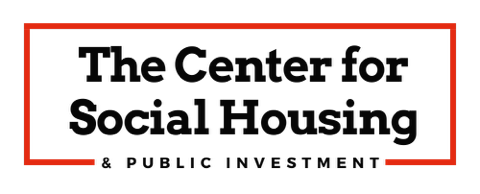The Solution: Social Housing
What is Social Housing
CSHPI promotes social housing systems that are created with the express purpose of making housing a human right. These models are sustainable, mixed income, publicly-owned, and permanently affordable. Here is how these types of social housing models operate.
First, the government looks at housing as infrastructure. This means localized investment in the production of thousands of units of publicly-owned, self sustaining, deeply/permanently affordable rental housing through a social housing model.
Second, there is no private developer, which means the profit motive is eliminated. The elimination of the profit motive allows social housing to operate with maximum economic efficiency while providing 100% affordability. When apartment buildings do not have to generate profits for developers and their investment partners, the building can sustain lower rents. Since social housing is publicly owned, it does not need to generate profits. This means that 100% of your rent is used productively. Each month, rents paid are first used to cover the operating costs of the building (maintenance and management costs). Once the operating costs are covered, the rent payments that remain (the surplus rent) are used to pay down the building’s construction costs.
Finally, in a social housing system, buildings contain a mix of incomes. The rents of the tenants with higher incomes offset the lower rents paid by people who earn less. This is called rent cross-subsidization. Along with tenant rents, social housing can offer space for ground floor retail. These commercial rents will also be applied to covering monthly operating expenses and paying off construction costs.
As such, social housing creates publicly-owned, self-sustaining, deeply/permanently-affordable rental housing.
Why Social Housing
Nationally, the median monthly rent in the U.S. surpassed $2,000 dollars for the first time. Currently, the Income needed to afford the average rent for a two-bedroom apartment in some of America’s largest cities is staggering:
Income needed in San Francisco: $170, 961
Income Needed New York, NY: $163,325
Income Needed Los Angeles, CA: $132,882
Income Needed Boston, Mass: $131, 679
Income needed Washington DC, $130, 607
Clearly, these numbers point to a systemic failure of the private market to meet the housing needs of working-class people. When the private market fails, it is incumbent on the government to fill the gap in order to protect the health and welfare of the general public.
Social housing is an efficient and productive alternative economic model to fill this gap. Social Housing models work because they start with the fundamental belief that Housing is a Human Right. Housing policy is then rationally designed to achieve this goal. This approach is in direct contrast with the current policies in the United States which views housing as a mechanism to generate profit.
There are successful forms of social housing models that exist both domestically and internationally- one of the most famous models is in Vienna Austria. Vienna has a population of about 1.9 million people and contains around 420,000 units of social housing. Social housing in Vienna is broadly affordable, about 80% of the Viennese population qualifies to access social housing. The housing is also extremely well maintained, architecturally significant, and built with community input. Taken together, these factors make social housing extremely popular. In fact, more than 60% of people in Vienna choose to live in social housing.
In essence, Vienna has created a “public option” to compete with the private sector. The competition has driven housing cost down across the board. Renters living in Vienna (a world renown global city) pay on average only 27% of their income in rent, this number includes both renters living in social housing as well as those renting units in the private market. This means that social housing not only produces affordable units, it also keeps the cost of market rate units down as well. This makes the cost of living in Vienna 52% cheaper than New York City.
The Vienna model of social housing demonstrates what can be accomplished if public resources are used to benefit people. Social housing models work to build housing systems independent of the need to generate corporate profits and thus are completely at odds with practices such as land speculation and rent seeking. These characteristics make social housing the way forward to take housing policy out of the hands of wall street and back into the hands of the people.
